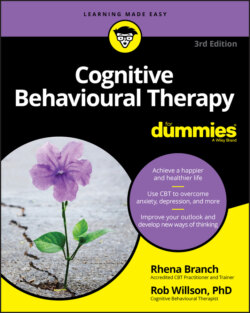Читать книгу Cognitive Behavioural Therapy For Dummies - Rob Willson - Страница 26
All-or-Nothing Thinking: Finding Somewhere In-between
ОглавлениеAll-or-nothing or black-or-white thinking (see Figure 2-2) is extreme thinking that can lead to extreme emotions and behaviours. People either love you or hate you, right? Something’s either perfect or a disaster. You’re either responsibility-free or totally to blame. Sound sensible? We hope not!
Unfortunately, humans fall into the all-or-nothing trap all too easily:
Imagine you’re trying to eat healthily and you cave in to the temptation of a doughnut. All-or-nothing thinking may lead you to conclude that your plan is in ruins and then to go on to eat the other 11 doughnuts in the pack.
You’re studying a degree course and you fail one module. All-or-nothing thinking makes you decide that the whole endeavour is pointless. Either you get the course totally right or it’s just a write-off.
© John Wiley & Sons, Inc.
FIGURE 2-2: All-or-nothing thinking.
Consider the humble thermometer as your guide to overcoming the tendency of all-or-nothing thinking. A thermometer reads degrees of temperature, not only ‘hot’ and ‘cold’. Think like a thermometer – in degrees, not extremes. You can use the following pointers to help you change your thinking:
Be realistic. You can’t possibly get through life without making mistakes. One doughnut doesn’t a healthy diet ruin. Remind yourself of your goal, forgive yourself for the minor slip and resume your diet.
Develop ‘both–and’ reasoning skills. An alternative to all-or-nothing thinking is both–and reasoning. You need to mentally allow two seeming opposites to exist together. You can both succeed in your overall educational goals and fail a test or two. Life is not a case of being either a success or a failure. You can both assume that you’re an okay person as you are and strive to change.
All-or-nothing thinking can sabotage goal-directed behaviour. You’re far more likely to throw in the towel at the first sign of something blocking your goal when you refuse to allow a margin for error. Beware of ‘either/or’ statements and global labels such as ‘good’ and ‘bad’ or ‘success’ and ‘failure’. Neither people nor life situations are often that cut and dried.
